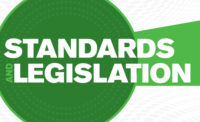The U.S. Department of Energy (DOE) will hold a public meeting on Wednesday, Oct. 22, from 10 a.m. to 1 p.m. in Washington, District of Columbia, to discuss a variety of issues related to the testing and calculation of the energy efficiency of refrigeration systems used in walk-in coolers and walk-in freezers (collectively, “walk-ins” or “WICFs”). In addition, DOE plans to broadcast the public meeting via webinar. You may attend the public meeting either in person or via webinar. Registration information, participant instructions, and information about the capabilities available to webinar participants will be published in advance on DOE's website. Webinar participants are responsible for ensuring their systems are compatible with the webinar software.
A walk-in is an enclosed storage space refrigerated to temperatures “above, and at or below” (depending on whether it is a cooler or freezer) 32°F that can be walked into, and has a total chilled storage area of less than 3,000 square feet. See 42 U.S.C. 6311(20). Each walk-in is comprised of three key types of components: Panels used for the ceiling, walls, and (for freezers) the floor; at least one door; and a refrigeration system. The discussion will focus solely on the mechanics of measuring the relevant values and the downstream calculations needed to rate the efficiency of WICF refrigeration system basic models that are either sold as mixed or matched systems.
At its most basic level, a refrigeration system uses two primary components — an evaporator coil unit and a condensing unit. Both of these components are connected together through the use of a refrigerant line. Within the refrigeration system market, some manufacturers produce both components, effectively creating a complete system for purposes of being able to rate the efficiency of a given walk-in refrigeration system. Other manufacturers, however, produce only the evaporator coils or the condensing unit. Recent modifications to DOE's WICF test procedure enable manufacturers in these single component-only scenarios to readily calculate the energy efficiency of their respective unit using specified default values for the other refrigeration system component that they do not manufacture. See 79 FR 27388 (May 13, 2014). Those recent modifications also allow manufacturers of walk-in refrigeration systems to use a mathematical model or computer simulation, known generically as alternative efficiency determination methods (AEDMs), in lieu of conducting a test when rating a WICF refrigeration system's energy efficiency.
The scheduled meeting is intended to assist interested parties, particularly those individual manufacturers who produce only one of the two primary refrigeration system components noted above, with applying DOE's calculation methodology when rating the efficiency of that manufacturer's component. This calculation methodology must be used when determining whether a manufacturer's individual component complies with the applicable energy conservation standards DOE recently issued, compliance with which is required as of June 5, 2017. See 79 FR 32050 (June 3, 2014).DOE plans to discuss the following issues:
•The scope of the refrigeration system test procedure, particularly, identifying which refrigeration components fall within the scope of DOE's walk-in regulations;
•The operation of the test procedure's methodology, including the methods used to calculate defrost energy consumption;
•The application of the test procedure when rating different walk-in refrigeration systems (i.e., mixed versus matched systems);
•The calculation of the ratings of a given walk-in refrigeration system component when only component (i.e. the evaporator coil unit or condenser unit) is produced; and
•The AEDM requirements as they apply to walk-in refrigeration systems.
DOE encourages all interested persons to submit questions to DOE that are relevant to the above topics in advance of the meeting date to ensure that the agency is able to fully address these topics. As the intent of this meeting is to help manufacturers to better understand how to rate their equipment, DOE will not be discussing the methodology or analysis used in developing the recently amended energy conservation standards for walk-in refrigeration systems.
To register for the webinar, click here.
Information courtesy of regulations.gov.






